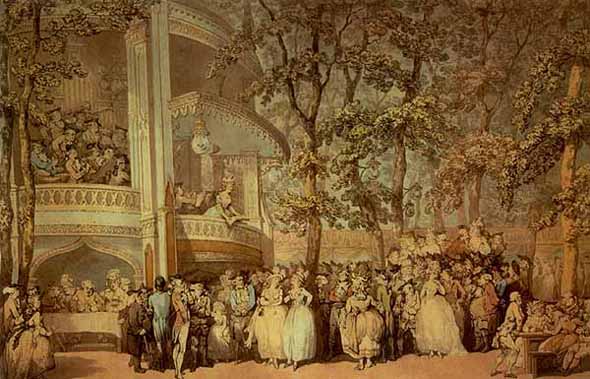
Vauxhall Gardens. By Thomas Rowlandson. 1784.
44Gossip
Masquerade
In a characteristic move,
Mrs. Crackenthorpe laments the new ability of the lower classes to resemble-and be mistaken for-the wealthy: "This town does so swarm with people in masquerade that one hardly knows a gentleman from his tailor, a lady from her semptstress, or a merchant's eldest son from Dick-Dapper that sweeps the shop" (no. 26). Her use of the word "masquerade" in this context indicates her attitude that lower class individuals who dress as persons of quality essentially wear costumes (of the upper classes). They pretend to be something they are not, much as an actress dresses up to play a role or a lady disguises herself for a masquerade ball.|
|
|
Vauxhall Gardens. By Thomas Rowlandson. 1784. 44 |
Indeed, the eighteenth century enabled the lower classes to dress as and associate with persons of quality as never before. Detailing and analyzing the various roles of the lower classes during this period, historian Peter Linebaugh asserts in The London Hanged: Crime and Civil Society in the Eighteenth Century that "masking, costume, disguise and fashion developed rapidly in the eighteenth century in direct proportion to the new urban settings of show and promenade." The new wealth of tradesmen and merchants and an influx of cheap goods (imitations of quality goods) into the marketplace allowed the lower classes to imitate the dress of the wealthy. At the same time, the establishment of new public spaces opened unprecedented possibilities for the lower classes to intermingle with the upper classes. Coffee-houses, gaming-houses, gin-shops, tea-gardens, and chocolate-houses became places for the "intermixture of social classes eating, drinking, gaming and flirting."
45That a portion of those considered the lower sort in the eighteenth century are able to masquerade as persons of quality vexes the authors of the Female Tatler; they warn their readers to guard against associations with those deceptively dressed like the upper classes. Since appearance alone no longer suffices to distinguish the poor from the wealthy, Mrs. Crackenthorpe advises individuals to "examine people's pretences, to prevent their sons being attack'd by gamesters, and their daughters drawn away by a notorious gang of fortune hunters, but in so courteous and obliging a manner, that they happen not to affront people of condition" (no. 26). Clearly, the Female Tatler suggests, masquerade puts the wealthy at risk of falling victim to the ill intentions of the destitute. Linebaugh indicates that Mrs. Crackenthorpe's fears are not unfounded, arguing that new public spaces "became one of the urban stages for the ambitious, resourceful
picaro," who prided himself on his ability to dupe, swindle, and steal from the unsuspecting gentleman or lady. (Linebaugh 121). Inherent in Mrs. Crackenthorpe's charge to examine individuals' "pretences" stands the implication that persons of quality can be distinguished from masqueraders when carefully scrutinized because the ill breeding of those in "costume" will eventually betray their true status. Here, the Female Tatler delicately balances the tension between warning readers to take seriously the possibility that the lower classes can look like and be mistaken for the wealthy and maintaining that, in the end, persons of quality are always distinguishable because their good breeding comes through in their carriage, deportment, and manners.
Main Page